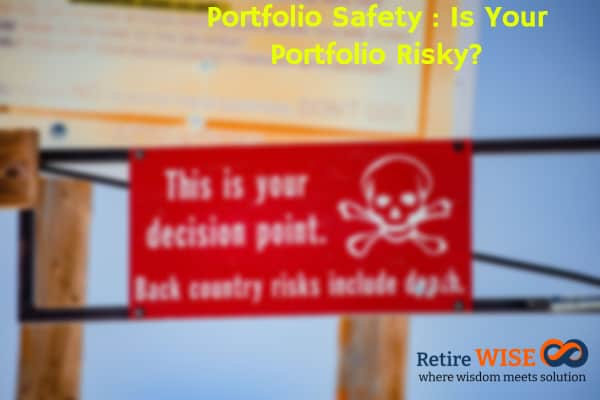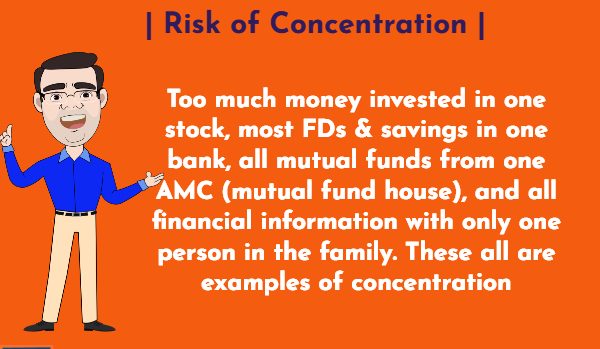How to Manage Risk in Your Portfolio in these Crazy Times?
The Merriam-Webster Dictionary defines risks as, among other things as:
- Possibility of loss or injury
- Someone or something that creates or suggests a hazard
- The chance that an investment (such as a stock or commodity) will lose value
Legendary investors have their definitions of risks.
Warren Buffet famously said, “risk comes from not knowing what you are doing.” While his partner Charlie Munger has emphasized, “risk to us is (a) the risk of permanent loss of capital, or (b) the risk of inadequate return.”

Must Check – How Healthy Is Your Mutual Fund Portfolio?
Another legendary investor Howard Marks says that he is “against the purported identity between volatility and risk as the former is an academic’s choice for defining and measuring risk.” According to him, risk comes from uncertainty or the unknowable future.
In the recently concluded India Today Conclave 2021, Rakesh Jhunjhunwala said, “Risk is the essence of life. If you don’t [take] risk, you are nothing.”
So, What is Risk After All?
Risk means different to different people – and rightly so as they all bring in a different perspective to the table. Similarly, risk in investment means different to different categories of people. For someone in their 70s and living off their retirement fund, equity investments are risky, while for a young professional in their 20s not going all-in equity is risky.
For most people investing in equity is risky as they are highly volatile, but for some people buying cryptocurrencies is not at all risky, which are far more volatile than equities! Therefore, defining a model to assess risk in your portfolio is risky too! It is a very subjective measure for most people, and they bring in their life experiences, learnings, and biases while defining what is a risk.
According to us, there are many things that we do as investors that add risk to our portfolio. Many of these things are the result of involuntary actions – not controlled by rational judgment. But some of them indeed are well-thought-out actions that do not go as we planned.
In this article, we try to introduce you to such Portfolio risks and how to avoid them.
Risk of Not Knowing Where It May Come From
Over the long run, stock markets have consistently given stellar returns beating all asset classes. But equities are volatile and for most investors, that means they are risky. If you cannot fathom even the thought of losing more than 30% of your portfolio value in a short period, then probably you are not cut out for direct equity investments.
Those who think that debt is the best way to go ahead, think twice. Bonds and debt can be risky too – ask numerous investors who deposited their life savings in DHFL, Sahara India, PMC Bank, Franklin Templeton MF Debt fund schemes, and AT 1 bond from Yes Bank (touted as Super FD).

Check –Is it the right time to rebalance your portfolio
Risk of Not Knowing What is Your Risk Tolerance
Risk tolerance is an individual’s or institution’s capacity to endure pain, hardship, or in case of investments, losses. Risk tolerance is as much of a psychological construct as it is a numerical one. Your current financial situation plays a key role in determining your risk profile.
For example, you trade in equities and cryptocurrencies but have assets worth Rs. 1 crore and liabilities worth Rs. 85 lakhs. With a net worth of only Rs. 15 lakhs, your risk-taking margin is very small. On the other hand, if you have assets worth Rs. 20 lakhs and no liabilities, then your risk profile is quite strong.
You may have to sit with an investment advisor to discuss your financial past, present, and future holistically to gauge your risk profile.
Must Read – Direct Investing In Stocks Is Risky
Risk of Concentration
Too much money invested in one stock, most FDs & savings in one bank, all mutual funds from one AMC (mutual fund house), and all financial information with only one person in the family. These all are examples of concentration. In some cases, concentration can bring enormous benefits and give you astronomical returns.
But for most mortals, concentration can bring unmanageable risk. See how:
- Employees have their largest allocation in the form of ESOPs of their employer company.
- Depositors of a troubled bank (PMC bank) or NBFC (DHFL) having their lifelong savings frozen up or written off overnight.
- Investors of respected and risk-free debt MF schemes (Franklin Templeton AMC) were left in limbo all of a sudden.
- The sudden demise of the primary bread earner in the family (COVID deaths) leaves a vacuum and there is no way to know anything about their financial, business, & legal positions, assets, and liabilities.
Risk of Over-diversification
Recently, I came across a colleague from a long-time back. He used to be as savvy an investor as they came. He was one of the “influencers” who motivated many people around him to invest in stock back in 2004-2005. In our casual discussion, he slipped in a simple fact, “Bhai Sahab, I have 24 mutual fund portfolios for different goals. Can you please suggest a couple more for these two goals?”
As you may have guessed I was shocked, more than astonished. But as I was dealing with a “learned” investor, I kept my shock and astonishment to myself and just gave a cursory look at his holdings. Just by the look of it, I could tell that more than 70% of his portfolio was redundant and was probably a result of his “investments” on the advice of a relative or friend.
The enormity of managing so many portfolios and the charges that he pays makes the whole point of MF investments completely irrelevant and ridiculed. This is an abuse of the terms goal-based investing as well as diversification.
Risk of Leveraged Investments
If you borrow money to invest then you are a leveraged investor, or rather a speculator. We always suggest that except for a few necessary debts – like for home loan, education loan, and sometimes business loan – all other kinds of leverages are instruments of an investor’s death. When you borrow to invest, you “hope” to earn more with less amount of money. You need to pay a fixed rate of interest, but your profits are uncapped.
One thing that you forget is that, if your bet turns sour, then not only you would lose your margin money, you still owe your creditors the loan amount as well as interest on it. The borrowed money is like a glass springboard – more likely to crack than to spring you up in the air.
Must Check – How Should You view Investment Risk?
Risk of Confusing Speculation with Investments
One of my acquaintances is an accidental investor! He is actually a trader but says he has invested for the long-term when he has stock in his account for more than a few weeks. In fact, what happens is that he could not sell the stock in the daily trade and nor in the next few days at a price level that he desires.
Similarly, many investors are “investing” in cryptocurrencies and Forex futures, options, and derivates. Doing so in the former is not illegal, per se, but is fraught with risks. Cryptocurrencies have seen swings of more than 20% in just a single day and are NOT an investment from any stretch of the imagination.
Trading in forex through apps is illegal in India, but the app developers are circumventing the minor loopholes in forex guidelines & rules to cheat retail investors.
Risk of Innumeracy – Percentages, Inflation, Taxation, and Charges
The biggest risk that an investor can bring to her/his portfolio is through innumeracy. If you cannot understand the difference between absolutes and ratios or you cannot calculate is the impact of a decline or appreciation in the value of a stock by a given percentage, then you are innumerate.
You must understand the concepts of inflation, taxation, and charges and how do they impact your investible surpluses, their returns, and yields. If you are ignorant about any of these, then you should better stick to the index funds.
Carl Richard Said “Risk is what’s leftover after you think you’ve thought of everything. It’s the car you never saw that kills you.” but still please share in the comment section.. do you think your portfolio is risky?